When it comes to pets, guinea pigs are little gems. So why wouldn’t we, as pet owners, want to ensure these gems sparkle as they should?
In pet stores, most cages labeled as guinea pig cages are way too small. Our little piggies need a lot of space to move around, and if you have a pair, even more so, meaning a bigger cage with keep them happy and healthy.
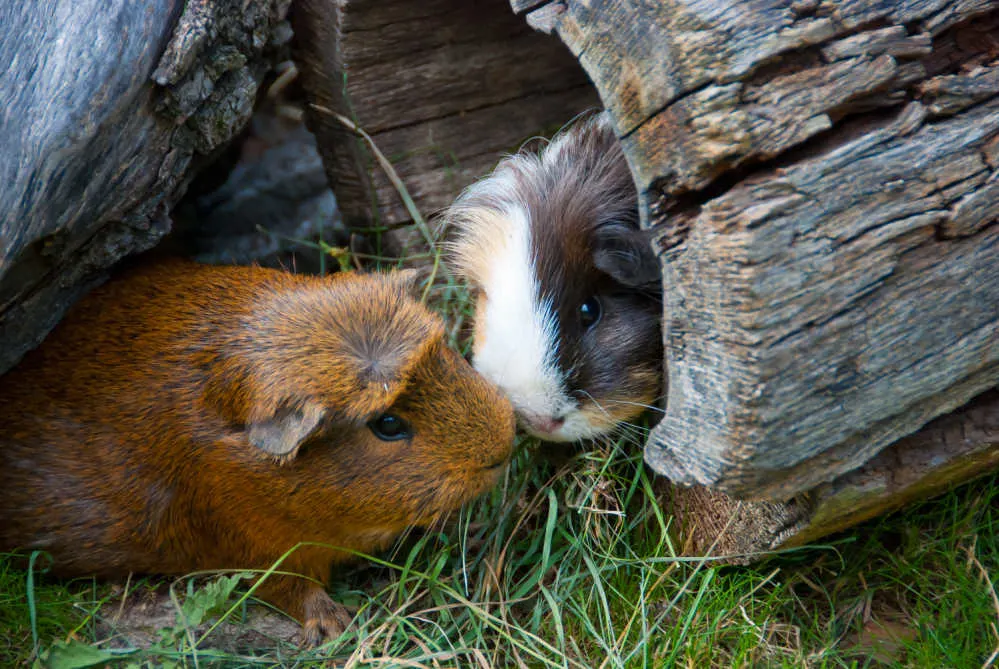
They also need separate areas to nest, eat, drink water, and use the bathroom. We can all agree that eating where you poop is not the way to live.
Guinea pigs also need a lot of exercise, which won’t happen in a cage that is too small to move around. This post will explore the importance of guinea pig cage sizes, especially for two piggies, as well as the minimum requirement for cage sizes.
We will also review how to choose the best cage for your fluffball to ensure they have plenty of space. Let’s dive into the minimum cage size for two guinea pigs.
Cage size for two guinea pigs
You should always try to house a pair of guinea pigs together because they can grow very lonely and depressed on their own. Guinea pigs are social creatures at heart and everybody needs a friend, right?
The Humane Society of the United States and the RSPCA in the United Kingdom recommend that the required size of a guinea pig cage should be 7.5 square feet (0.7 square meters) for a single guinea pig on its own or indeed for two guinea pigs.
However, this is the absolute minimum when it comes to cage size.
If you adopt your fur babies from an animal shelter, they will usually recommend the right cage size to be at least five feet by two feet (1.5 by 0.6 meters), which is much larger than the Humane Society suggests, and, quite frankly, the better option.
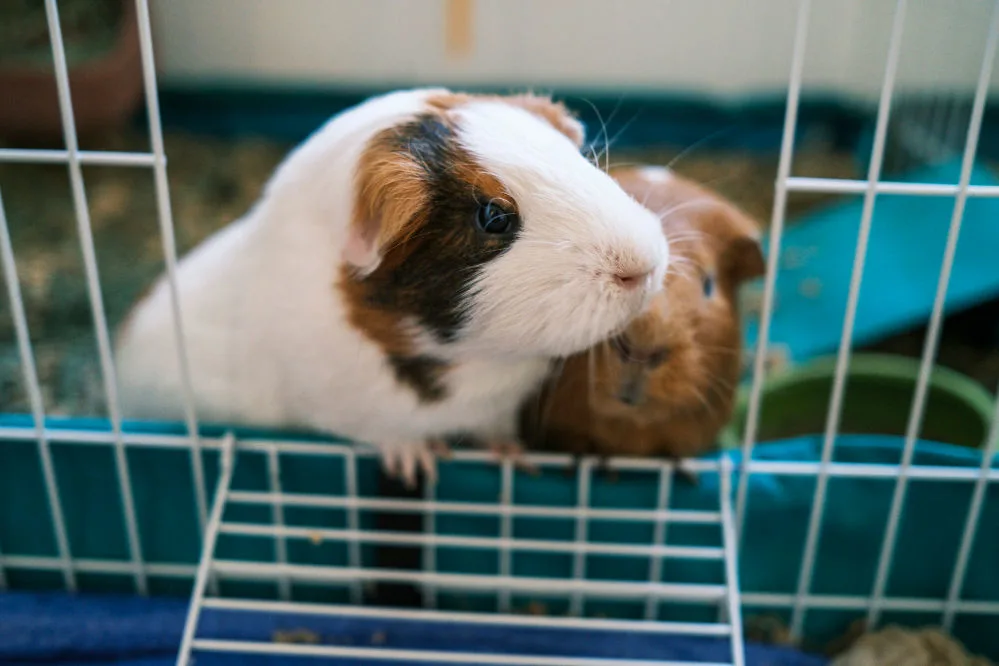
Going up to 10.5 square feet (0.9 square meters) is preferable and will ensure extra space and more comfort for your cavies. The recommended cage size is five feet by two feet (1.5 by 0.6 meters), but four feet by two feet (1.2 by 0.6 meters) is the minimum if you have two guinea pigs.
You can even go up to 11 square feet (one square meter) to pamper your piggies with spacial luxury.
Benefits of a big cage
One of the most fundamental forms of enrichment you can offer is a larger enclosure. Without enough things to do, guinea pigs can grow sad and bored. Imagine living in a walk-in closet your entire life; it would be pretty dull, even with short intervals outside.
With ample space to exercise, your guinea pigs are less likely to suffer from ailments like heart diseases, diabetes, bumblefoot (pododermatitis), and anal impaction. This spares them pain and suffering and cuts down on your veterinary expenses – which is a good idea for your piggies and your wallet.
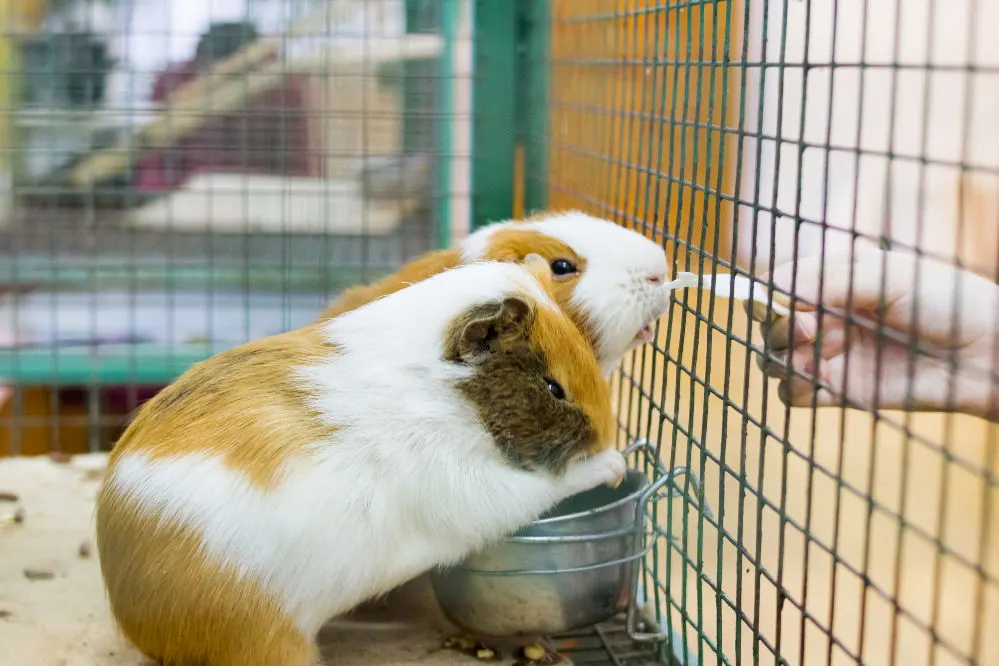
You can easily spot-clean a larger cage on a daily basis because your piggies will decide to dedicate a corner as their restroom, so seeing where the waste is will be a piece of cake. Piggies poop a lot, so having it all in one corner or side of the cage is quite helpful.
Another advantage is that since they have more room to display their natural habits, your guinea pigs’ personalities will be more exposed. Perhaps you have a cavy that loves running around for hours, and they wouldn’t be able to do that in a small cage. Cavies who are shy and like hiding will have more places to burrow in larger cages.
Location is important
You must choose where to put your guinea pigs in your house once you’ve chosen the appropriate shelter. These are some things to think about.
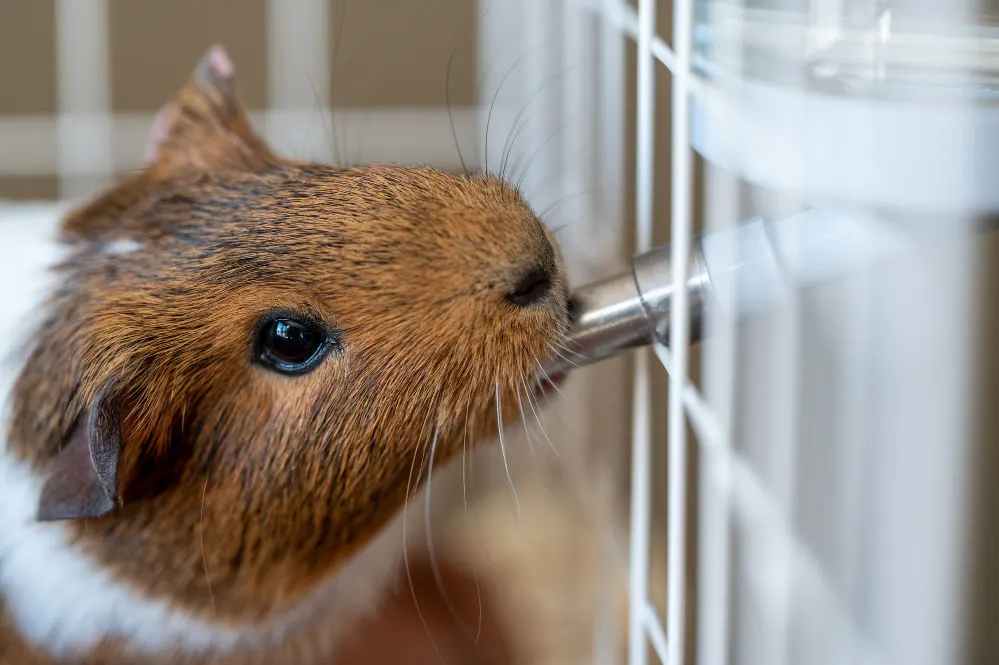
Activity level
Even though they also snooze, guinea pigs are most active between dawn and dusk. They can be rather loud creatures. So unless you can sleep through a hurricane of tiny feet tapping around all night, don’t put them in your bedroom.
Temperature
For guinea pigs, the ideal temperature range is between 65ºF – 75°F (18ºC – 23°C). Housing for piggies should be placed far from hot areas that have direct sun, wood stoves, fireplaces, and heating vents. Guinea pigs are especially prone to heat stroke because they cannot sweat when they get too hot.
Avoid placing your guinea pig’s cage in a chilly room, breezeway, garage, or other cold location. They can get sick from being exposed to chilly drafts, so keep your cage away from any windows or doors. Investing in a cage with a stand will keep them warmer because the base is off the ground.
Cavies don’t handle excess humidity well, either. The possible dampness can increase their susceptibility to illness by encouraging mold growth in their hay and bedding.
Noise
Guinea’s ears are incredibly delicate, so keep them away from the TV or stereo. Even though they want to be around people, they also like to have a private, quiet place to retreat to if they start to get anxious around commotion. You can add a wooden hideout to your cage to provide them with somewhere to hide.
Do male pairs need more space?
The insufficient room makes male guinea pigs more likely to fight. It’s therefore advised to move up to the next cage size for males that are kept together so they don’t bump heads too often.
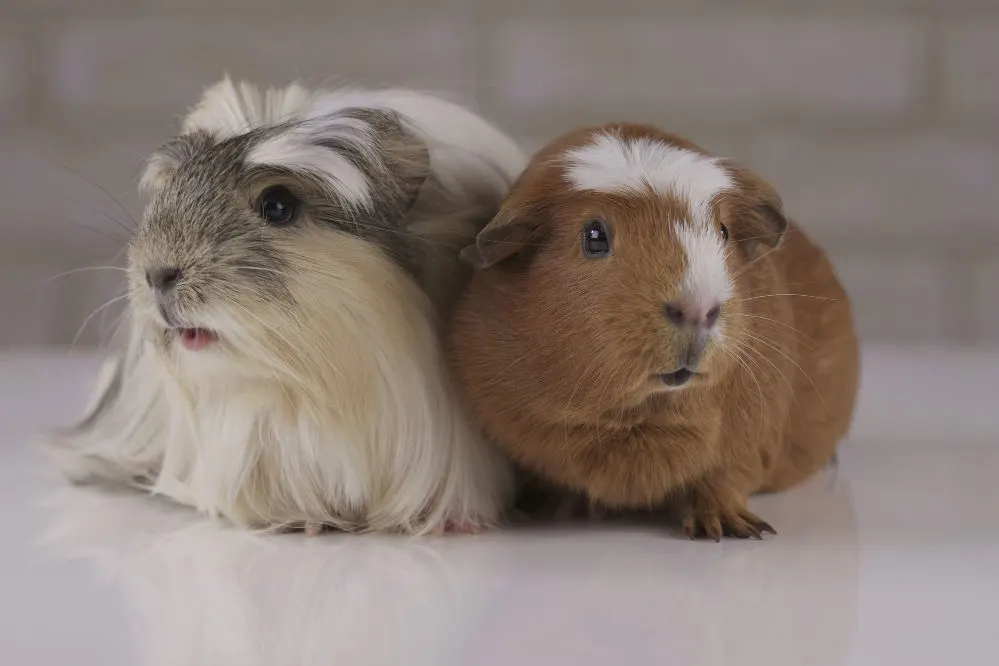
Although, whether you have a pair of male or female guinea pigs, it’s best to increase the cage size whenever possible; a happy guinea pig is one that can trot around with ease.
Issues with small cages
You could experience several issues with your pets if you keep your guinea pigs in a tiny cage, including the following:
They get dirty quickly
The limited space makes a small cage dirty much quicker. This implies that you will need to clean the cage more frequently, or it will smell.
Your guinea pigs may end up sitting in wet or soiled bedding that will get into their hair in a dirty cage, which is unhygienic for them. This may lead to sores and draw flies, increasing the risk of the potentially fatal illness flystrike. Make sure your cage has fleece bedding that can be washed or paper bedding that absorbs liquid.
Inhaling the ammonia that comes from urine that hasn’t been cleaned up can also damage a guinea pig’s nasal passages and potentially make them sick. Frequent cleaning is a must if you have multiple guinea pigs, especially if they are housed in a cage that is too small.
Your cavies might fight
The likelihood that guinea pigs would act aggressively toward their cage mates increases when they are kept in overly small cages. In some cases, this can lead to fatalities or very catastrophic injuries.
Depression
Your guinea pigs could become sad and passive. They require sufficient space to roam, play, and run around because they are very active pets. They won’t have a high quality of life if they can’t do this.
As a result, they might get depressed. There could be a variety of causes for your guinea pigs to spend most of their time sitting in a corner or hiding, but a smaller cage may be to blame.
How to choose the right cage?
Now that the fundamentals have been covered, let’s apply this knowledge to determine the ideal cage size for your guinea pigs. You’ll have chosen the best guinea pig housing if you follow each of these procedures.
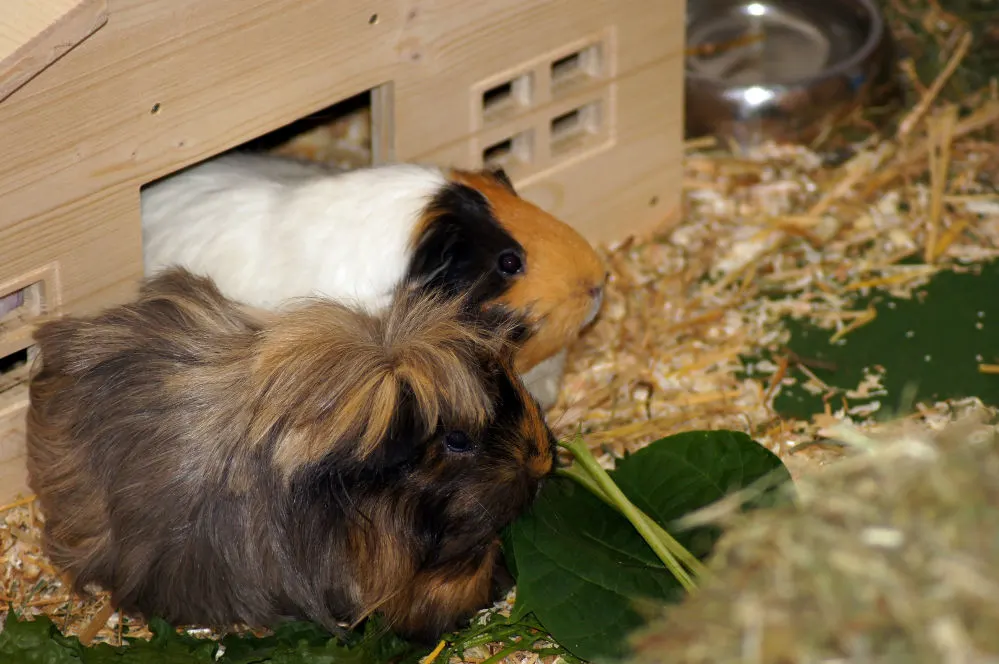
1. Count your guineas and calculate the right size
The first step is counting the number of guinea pigs you currently have that will be housed in the cage. Each extra guinea pig demands more space.
2. Make a plan and choose a location
Consider the future — is it possible that you might get additional guinea pigs later? If so, it’s advisable to plan ahead and buy an enclosure that will be big enough for when you eventually get them. Either that, or a cage that can be added on to.
But first, you need to choose a good location for a cage before you even consider looking at them. You will have certain space limitations to work with as a result. It’s possible to find yourself with a cage that is big enough for your guinea pigs, but it won’t fit in an appropriate area.
3. Look at your options
The foundational work is largely finished at this stage. It’s time to start looking at what’s accessible right now.
Check out Chewy, Amazon, or your neighborhood pet store. There are probably many cages available in the size you need. Make a list of the suitable dimensions of enclosures at this step and get shopping.
4. Pick the best cage according to your needs
It’s time to eliminate options and select just one cage to buy now that you have a list of cages that are the ideal size for your guinea pigs.
Make sure it fits the space you measured and suits your guinea pigs’ needs. Then, evaluate your selections based on price, number of levels, material, and previous customer reviews.
Where to buy guinea pig cages
Even though your first instinct might be to visit a pet store, to tell the truth, many high street pet shops don’t stock cages large enough to house more than two female guinea pigs. They’re smaller than males, so that already says a lot. And even though the cages are too small, many stores frequently tell customers they’re fine for guinea pigs. This usually results in the customer buying the cage and unintentionally ending up with some unhappy pigs.
One of the few premade cages that are genuinely acceptable and a good size for guinea pigs is made by MidWest Cages. It is 47″ (119 cm) by 24″ (60 cm) in size, with walls that are 14″ (35 cm) tall.

This provides around 7.8 square feet of space (0.72 square meters), a little more than the 7.5 square feet (0.7 square meters) minimum required for two guinea pigs. This cage has the advantage of being pre-built and reasonably simple to erect.
Also, you may get outdoor wooden hutches online. Because they are larger, better insulated, and last longer, most people find these are great options for housing guinea pigs, even though they’re usually used as rabbit houses.
Guinea pigs cannot regulate outside temperatures well, so the Humane Society discourages keeping your piggies outside without the proper set-up. If you want to go with this option, look at some smaller hutches that you can keep inside.

Final thoughts on guinea pig cage size
Cages for guinea pigs are widely available, but that does not mean they are all suitable for your guinea pig. Guinea pigs and hamsters are very different, so don’t be fooled by cages that are said to be for both.
Your piggies require much more space for a healthy life and choosing a large enough cage is the most important decision you can make for your pets.
If you follow the instructions in this guide, choosing a cage with enough room for two guinea pigs should be simple.
Once you have chosen your cage and set it up, it’s time to ensure the inside is comfortable for your piggies by deciding on the right bedding and toys to add. This is where the fun part comes in. You will have some very happy cavies by the end of this journey.
Steph Dyson is a travel journalist by trade but a lover of all small pets. She’s been a pet mum to everything from gerbils to guinea pigs, rabbits to hamsters, and fish to dogs of all shapes and sizes. She wants to share her years of experience with small pets and make Small Pet Guides the go-to website for pet owners seeking information and care advice.

